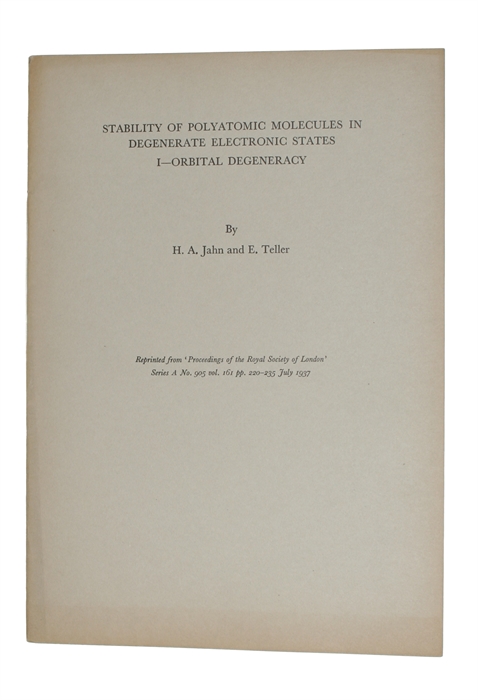THE JAHN-TELLER EFFECT
JAHN, H. A. (+) E. TELLER.
Stability of Polyatomic Molecules in Degenerate Electronic States. I - Orbital Degeneracy. Reprinted from "Proceedings of the Royal Society of London", Series A, No. 905, Vol. 161, pp. 220-235, July 1937.
(Cambridge, Cambridge University Press), 1937. Royal8vo. Original printed wrappers. Faint fading to extremities of wrappers, otherwise mint. 1 blank leaf, pp. (220)-235.
First edition, offprint, of Jahn and Teller's important publication on the geometrical distortion of non-linear molecules - now known as the Jahn-Teller effect - which was to become a groundbreaking tool for research in crystals and molecular configurations in general.
"The Jahn-Teller effect is one of the most fascinating phenomena in modern physics and chemistry. It emerged in 1934 in a discussion between two famous physicists [...] and grew into a general tool for understanding and an approach to solving molecular and crystal problems, which is applicable to any polyatomic problem. The first formulation of the effect as instability of molecular configurations in electronically degenerate states proved to be the beginning of a whole trend which rationalizes the origin of all possible instabilities of high-symmetry configurations, and the peculiar nuclear dynamics resulting from these instabilities as well as the origins of all structural symmetry breakings in molecular systems and condensed matter. The next significant resurgence of interest in the Jahn-Teller effect is related to the late 1980s and is still continuing. It was triggered by one of the most important Nobel Prize discoveries in physics of our times inspired by the Jahn-Teller effect: the high-temperature superconductivity." (Bersuker, The Jahn-Teller Effect).
"The Jahn-Teller effect continues to be a paradigm for structural instabilities and dynamical processes in molecules and in the condensed phase. While the basic theorem, first published in 1937, had to await experimental verification for 15 years, the intervening years have seen rapid development, initially in the theoretical arena, followed increasingly by experimental work on molecules and crystals. Among the many important developments in the field we mention cooperative phenomena in crystals, the general importance of pseudo-Jahn-Teller couplings for symmetry-lowering phenomena in molecular systems, nonadiabatic processes at conical intersections of potential energy surfaces and extensions of the basic theory in relation to the discovery of fullerenes and other icosahedral systems." (Köppel, The Jahn-Teller Effect: Fundamentals and Implications for Physics and Chemistry).
Edward Teller's greatest long term contribution to science is his present discovery. He was, however, a highly controversial physicist in contemporary science: "Though an accomplished theoretical physicist, Teller is best known for his early contributions to the development of the hydrogen bomb and his unwavering defense of nuclear weapons. His support of weapons and opposition to test bans, along with his advocacy of projects such as the Strategic Defense Initiative, made him both one of the most controversial physicists of the twentieth century and one of the most politically influential.
Dawn of the Atomic Age. Teller first began to consider the possibilities of a hydrogen weapon in late 1941 when, during a brief period at Columbia University, he met with Nobel laureate Enrico Fermi. Fermi had proposed that a fission explosion might create conditions close enough to what occurs within stars to induce the fusion of heavy hydrogen or deuterium nuclei, which, unlike standard hydrogen nuclei that contain only one proton, feature both a proton and a neutron. Though Teller was initially skeptical, he quickly established himself as the leading proponent of fusion weapons. During a 1942 meeting of top physicists at the University of California at Berkeley called by J. Robert Oppenheimer to discuss the potential development of fission weapons, Teller suggested that the prospect of building a hydrogen weapon, a "Super," be explored as well.
Though Teller's advocacy of nuclear weapons put him at odds with many in the scientific community, it also provided him with powerful allies in the military and government who shared Teller's vision of sophisticated, often then-unrealized, technology playing a major role in defense. Whereas he never achieved the same high profile as Oppenheimer once had, Teller maintained an important voice on issues of science and defense in numerous administrations up to and including that of Ronald Reagan." (DSB).
Order-nr.: 47624

